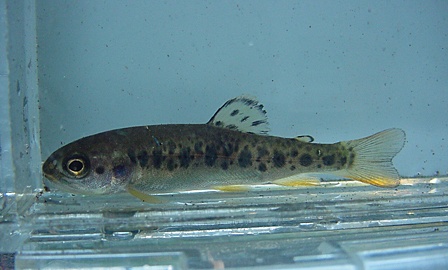As winter comes to an end, tiny silvery fish with orange-tipped fins begin to emerge from the gravel in several Orcas and San Juan Island streams. Barely an inch long, they will spend the summer feasting on larval insects, often in shallow pools with only a trickle of water to keep them cool and aerated. Some will stay in fresh water for the rest of their lives. Others will swim downstream in fall—frequently over waterfalls and the spillways of private ponds—to begin an ocean migration from which they may eventually return as iridescent gold speckled adults with a distinctive red slash on their jaws: coastal cutthroat, the native sport fish of the San Juan Islands. Of all the Pacific salmon, only cutthroat seem to tolerate low summer flows in our islands’ streams. Cutthroat and rainbows (steelhead) are commonly called “trout” but they belong to the same genus (Oncorhynchus) as Pacific salmon. Unlike other Pacific salmon, they can either spend their entire lives in fresh water, or go to sea and return more than once to spawn in their natal streams. “Sea-run” cutthroat are simply the individual fish that leave and return. They are generally larger than the “resident” cutthroat in the same stream, but genetically they are identical. If a landslide or poorly installed culvert completely blocks a stream, cutthroat can thrive above the barrier until their access to the sea is restored. In Cascade Creek, coastal cutthroat migrate downstream to the sea over dams and waterfalls but cannot return: one-way gene flow. Such populations can be important reservoirs of genetic diversity for cutthroat throughout entire Salish Sea.
Coastal cutthroat were more widespread and abundant in the island just 40 years ago, judging by old guidebooks and the recollections of local fly fishermen. It’s easy to see why. Roads cross our streams, often over tons of fill with culverts that are perched or simply too small for fish passage. Small concrete and earthen dams block many streams, some originally built for irrigation or drinking water, but most associated with residential ponds. Homeowners have removed trees and shrubs from stream banks. Reducing flows and shading means warmer water and less oxygen in summer when most of our cutthroat are confined to pools. Many streams now go completely dry in summer, or barely trickle for five or six months of the year. This includes some of our largest watersheds, such as False Bay and Crow Valley. As flows decline, so do the numbers of cutthroat.
A cutthroat population we documented on Orcas just four years ago disappeared in 2008, for example, apparently because a single residential pond was enlarged.
Planting fish from elsewhere isn’t the answer: it’s part of the problem. In recent stream surveys we found more exotic fish (Atlantic brook trout, fathead minnows, large- and small-mouth bass, bluegills, pumpkinseeds, carp) than native ones, as well as lots of bullfrogs. All of the exotics eat cutthroat eggs and fry voraciously. Even Moran State Park is importing fish for sports fishermen, rather than helping save our native fish.
Only four San Juan County streams still have coastal cutthroat, and the only one with reliably year-round stream flow (Cascade) has the worst problem with exotic fish. While some landowners are beginning to work together to restore cutthroat populations on their property, our county government has not yet added cutthroat to its list of rare or threatened species, and this limits the protection (and restoration funding) available to our only truly native sport fish.
To learn more about coastal cutthroat, other native salmonids, and habitat surveys in San Juan County visit www.wildfishconservancy.org as well as www.kwiaht.org. And if you have questions about a stream or pond near where you live, contact Russel Barsh at RLBarsh@gmail.com.





